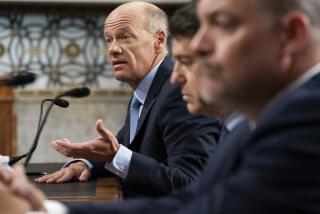TV Reviews : ‘Frontline’ Probes the S&L; Bailout
“I think we hit the jackpot,” exuded President Ronald Reagan when he signed legislation in 1982 deregulating American savings and loan institutions. Six short years later, the jackpot had been pillaged, as S&Ls; were collapsing under the weight of innumerable bad (mostly real estate) investments. Who Reagan’s “we” really was is doggedly investigated by reporter-host Robert Krulwich in “The Great American Bailout,” care of “Frontline” and the Center for Investigative Reporting (tonight at 9 on KCET Channel 28 and KPBS Channel 15, and 8 p.m. on KVCR Channel 24).
Before he drops his political bombshells, though, Krulwich tours Texas, the heartland of S&L; failures, to track the nature of the financial collapse. He could have devoted more time to the anatomy of the wildcat banking that ran amok in the ‘80s--personified, for instance, in Neil Bush, George Bush’s son, and the Denver-based Silverado S&L.; Yet Krulwich clearly summarizes for the lay viewer how the deregulated Silverados of the country, indulging in high-risk investments and blind real estate deals, were swamped when regional economies, especially in the Southwest and New England, suffered near-depressions.
The central character of “The Great American Bailout” is the Resolution Trust Corp. (RTC), designed by the Bush Administration to sell off S&L; assets, the remnants of those countless bad deals. It is a fire sale, though, of unprecedented proportions, for as mounting interest and delays are jacking the bailout cost from an initial $50 billion to $600 billion and counting, the RTC haplessly undersells assets: A great deal for speculators--especially billionaires with loads of liquidity--but a disaster for U.S. taxpayers.
One speculator, Joe Smith, calls it a “boo-boo”; retiring RTC chairman L. William Seidman calls it “the mother of all government mistakes,” and warns of Debacle II, in which the Federal Deposit Insurance Corp. may run out of money to cover bank deposits nationwide before the end of 1991.
And yet, as Krulwich uncovers, the bailout costs could have been a fraction of today’s mammoth bill had the Reagan Administration, via their S&L; regulator, M. Danny Wall, publicly stated the actual S&L; loss and immediately plugged holes in the decaying financial dam. Of course, that would have been during the 1988 presidential campaign.
More to Read
The complete guide to home viewing
Get Screen Gab for everything about the TV shows and streaming movies everyone’s talking about.
You may occasionally receive promotional content from the Los Angeles Times.






